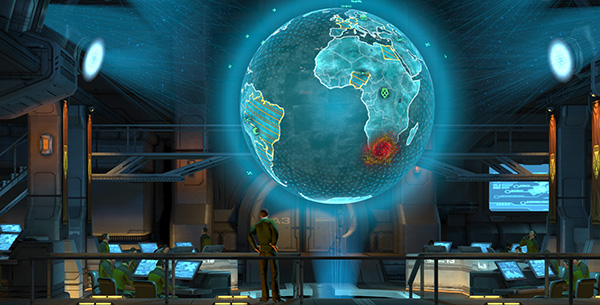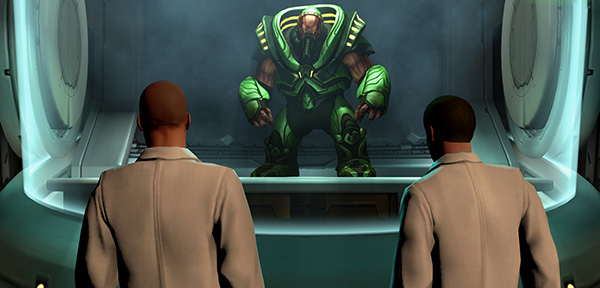 You're running out of ammo, the last medikit you saw was three towns behind, and that nice guy shooting at you just got a sniper to help him out.
You're running out of ammo, the last medikit you saw was three towns behind, and that nice guy shooting at you just got a sniper to help him out.
Without divine intervention and after that nice guy gets a lucky shot (and why wouldn't he?), you (or what's left of you) are probably headed to the nearest respawn point. And just like that, within the game, Pum! Your character appears out of nowhere.
Save points are a bit different. Usually, in games that allow you to save at any moment (ie: Deus Ex: Human Revolution—and I'm glad it lets us!), you just reappear in the same exact spot with the same exact gear you had.
Other games save when a big boss battle is coming up or when you choose to save (e.g. Serious Sam 3 BFE), and you just reappear on the point where you saved.
Saving a game and respawning is something that happens outside of the world of the game; the player is conscious of this, but the character is not, thus breaking the fourth wall. But there are exceptions to this rule, and Borderlands is one of them. So, how could one imagine a respawn point working?
The physics of respawning

In Borderlands, there are New-U stations that "store the character DNA against the possibility of accidental death or dismemberment" and can "digistruct" an entirely new body to replace the recently deceased one, a hand-wavey way to explain how the game save works.
We're going to discuss a bit of physics in this article, but thinking about an action game, being completely faithful to the laws of physics would be a bit boring. For example, if you die, you die, and that's the end, as long as our knowledge of the laws of physics goes!
New-U stations save the game when the character walks within range of it. We will get into the physics of the matter (if you pardon the pun), but just the idea of explaining why a character can reappear is interesting. There's even a tunnel when you're being brought back and an associated cost of 7% of your character's funds! It can be a lot from the player's perspective, but that's just pocket change considering you are actually "reconstructing" a character.
In a nutshell, New-U stations use solid light to digistruct a person, weapons from holsters, even cars. Therefore, the DNA explanation mentioned above is not sufficient. When you are reconstructed from a New-U station, the character returns with all its weapons, ammunition, clothes, etc. So if the New-U station stored only DNA, it would be a bit hard to reconstruct stuff that doesn't have DNA to begin with—think back-in-time-terminator-naked style. There's also the use of another term, "solid light," that is an actual scientific term, but again applied in a science fiction way, in a sense of light transforming into matter.
So how would a more physics-based "reconstruction" work?
Making a "new you" (who's exactly like your "old you")

Lawrence Krauss (a fantastic physicist and writer) did some calculations on a similar problem, the transporter from Star Trek. There are other issues that Krauss discusses, but the physics of acquiring the data from the object and reconstructing it would be similar. Krauss even goes into a deeper philosophical question: are human beings only the sum of their atoms? Is there something else that makes us human, besides matter? It's a very interesting question, but one that we will not delve into. So we're going to stick with physics questions: how much information would one need to store in order to recreate a human being? How do you acquire this information? And how much energy is needed to do so?
The average human body is composed of 1x1028 atoms.
To be able to reconstruct it from a stored pattern, first this pattern must be stored, of course. But how would one go about doing that? The scanner would have to acquire the position and momentum of all atoms, without displacing them. It would need to determine the type of atom that you're scanning, too. It also would have to do it very quickly, taking into account that the character probably wouldn't be standing still. And here quantum mechanics shows to start spoiling the fun, with its pesky Heisenberg principle.
The Heisenberg principle states that, independent of the measure apparatus or future technologies, there are certain combinations of measures that are impossible to be made with arbitrary precision.
For example, it is possible to determine very precisely the position of a subatomic particle—like an electron—but not the momentum at the same time, and vice versa, or the state that the particle is, but not how long the particle will stay in that state.
So for our "scanner beam" to be able to selectively "lock" on a particular atom (which would be a feat on its own) and acquire its information, would disturb that same atom from its present state, somewhat irreversibly. It gets even worse, since, if we need to increase the precision of the beam to get a higher resolution, more energy would be needed, and the more that poor atom would be disturbed. And all that would be done within seconds!
To keep going, let's now assume that this scanner beam works. How much space would be needed to store all this information?
But where would we store all this?

We would need to store not only the position and velocity of each atom, but also its energetic state, whether it's making a bond with other atoms, the vibrational and rotational states, etc.
In physics, each of these pieces of information is called a degree of freedom, and a system is determined if all the degrees of freedom can be defined.
Let's say that we can store all the degrees of freedom of all the atoms. Let's take an educated guess and say that all the degrees of freedom of one atom can be described by 5kB. While we're at it, let's also take into account the weapons and stuff that you carry on that giant backpack, and say that we need to store 1x1029 atoms.
That would give us 5 x 1029 kilobytes, or 50000 yottabytes of information to be stored (and retrieved!) in a few seconds.
Given the world's current supply of hard drives, we couldn't get a single yottabyte. There are some recent calculations (using the Bekenstein limit) that estimate the information needed to describe a human being to be around 1x1044 bytes, considering the maximum amount of information given using a finite amount of energy in a finite region of space, which happens to be larger than our previous estimate.
You died! What happens now?
You died, fini, caput, so the New-U station needs to reconstruct you. We got a nice blueprint of 50000 yottabytes with all your information.
First problem: we need the atoms! It shouldn't be a big deal for the more common ones, like oxygen (65%, in mass), carbon (18% in mass) and hydrogen (10% in mass).
Things start to get a bit more problematic with the rare earth ones, even uranium and beryllium, so each New-U station would have to have an "atoms stock" to be able to reconstruct a character. And remember, there's also all the weapons… It seems that the weapons are recreated from scratch when the character is recreated, but dematerialized to "hard light" when the character is not using it.
But wait! It gets even more complicated…
So far, we only dealt with atomic level problems, considering that only saving the atoms themselves and not its constituents is necessary.
Each atom is composed by some number of nucleons (protons and neutrons) and electrons, and a lot of empty space. Really, a lot: more than 99% of the mass of the atom is at its center, where the nucleons are, but the size of the nucleous is 10000 smaller that the atom itself.
What prevents things falling through other things is the electric field, or the repulsion of the electric field by equal charges. Chemical bonds are formed to minimize the energy, but getting the atoms together can be a bit tricky, exactly because of that electric repulsion.
There are also reactions that need energy to start and keep going, and others liberate energy when the chemical bonds are formed from the free elements. How much energy? We will have to simplify greatly here: some chemical reactions liberate energy, while others absorb it, so it's not only a problem of putting everything together, but also putting or removing the right amount of energy in the right order.
After seeing the enormous amount of information that would need to be scanned and stored, the energy and materials that would be needed and with all the difficulties that physics presents us, it's not like we would see a New-U on the corner anytime soon (or ever), but the possibilities for understanding the science behind the possible processes is very interesting. There are some fundamental physical barriers and others that are more technological. But nonetheless, not breaking the fourth wall is awesome and talking physics about a game is always awesome.
And all this for only 7% of your funds!
Ivan is a computational physicist and postdoctoral fellow at Laval University and science media consultant for Thwacke Consulting. For more follow Thwacke on Twitter and Facebook!

Editor's note: Our guy at Thwacke, a Canadian outfit that advises game developers in all things science, writes to us and says he's got an expert who can explain how the Zerg in StarCraft have a whole lot in common with real insects. More »
 Here's a look at the new costumization options available in Borderlands 2. Each set is available for 80 Microsoft Points or $0.99 / £0.75 / 0,99€ for the Xbox 360 and PS3/PC, respectively (separate from the Season Pass). You can find a shot of the "Madness" set below.
Here's a look at the new costumization options available in Borderlands 2. Each set is available for 80 Microsoft Points or $0.99 / £0.75 / 0,99€ for the Xbox 360 and PS3/PC, respectively (separate from the Season Pass). You can find a shot of the "Madness" set below.



















